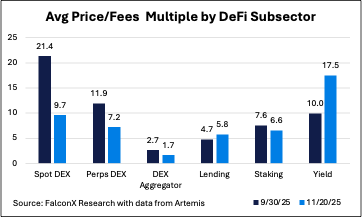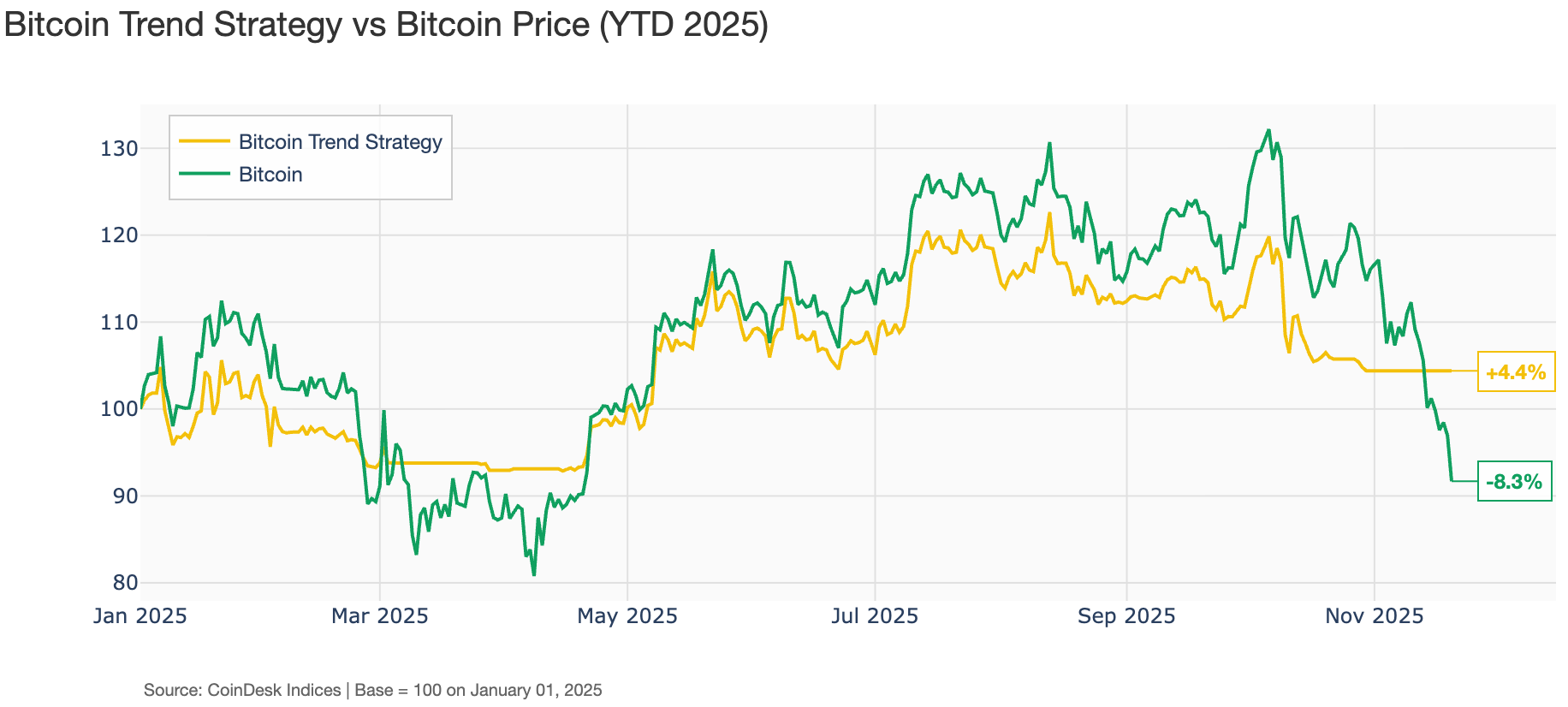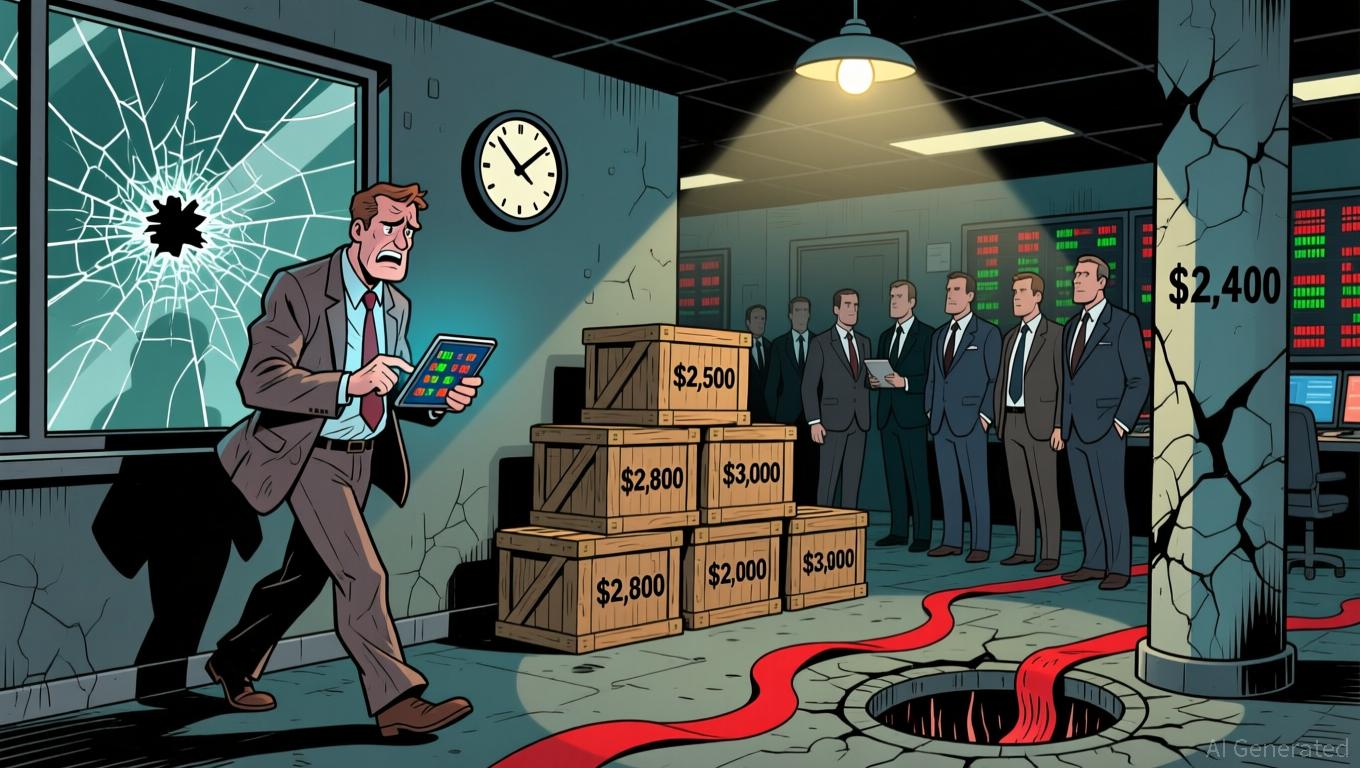Crypto Long & Short: The Striking Dichotomy in DeFi Tokens Post 10/10
Welcome to the institutional newsletter, Crypto Long & Short. This week:
- Insights on DeFi sector growth in 2026 by Martin Gaspar of FalconX
- Top headlines institutions should read by Francisco Memoria
- Analysis on investor sentiment from the relentless sell-off by Andy Baehr
- “Altcoins vs BTC performance” in Chart of the Week
-Alexandra Levis
Expert Insights
The Striking Dichotomy in DeFi Tokens Post 10/10
- By Martin Gaspar, senior crypto research associate, FalconX
The October 10th crash continues to reverberate in the crypto market with broader softness across sectors. It’s especially notable in DeFi, the lifeblood of on-chain activity today, and the one sector that generates the majority of crypto token revenue.
Let’s take a quick glimpse of where we are. Of a subsect of 23 leading DeFi names across the decentralized exchange (DEX), lending and yield verticals, only 2 are positive YTD as of November 20, 2025. QTD, the group is -37% on average, highlighting the damage this extended selloff has done. But the mixed price action reveals some nuances.
1) Investors seem to be opting for safer (‘buyback’) names or allocating to names with fundamental catalysts. On the buyback side, names like HYPE (-16% QTD) and CAKE (-12%) posted some of the best returns for larger market cap names in the cohort, indicating investors may be allocating to them or that their price has been supported by their substantial buybacks. Meanwhile, MORPHO (-1%) and SYRUP (-13%) both outperformed their lending peers on idiosyncratic catalysts, such as minimal impact from the Stream finance collapse or seeing growth elsewhere.
2) Certain DeFi subsectors have become more expensive, while some have cheapened relative to Sept 30, underscoring the changing landscape post the October 10 crash. Spot and Perp DEXes have seen declining P/S multiples as their price has declined faster than protocol activity. In fact, some DEXes such as CRV, RUNE and CAKE have posted greater 30D fees as of Nov 20 compared to Sep 30. We’re seeing similar trends across perp DEXes with HYPE and DYDX multiples compressing faster than declines in their fee generation.

3) Lending and yield names have broadly steepened on a multiples basis, as price has declined considerably less than fees. For example, KMNO’s market cap fell 13% over this period, while fees declined 34%, according to data from Artemis. Another factor may be that investors are crowding lending names in the selloff, considering lending and yield-related activity is often seen as stickier than trading activity in a downturn. Lending activity may even pick up as investors exit to stablecoins and seek yield opportunities.
This positioning may reflect where investors think the DeFi sector will see growth in 2026. On the DEX front, QTD performance suggests investors expect perps to continue to lead, and HYPE’s relative outperformance may point to investor optimism around its ‘perps on anything’ HIP-3 markets, which are seeing their highest volumes as of Nov 20. On the other hand, the only crypto trading category seeing record volumes lately are prediction markets. Therefore, the cheapening in the DEX sector may be warranted on lower growth expectations. On the lending side, investors may be looking to more fintech integrations to drive growth. AAVE’s upcoming high-yield savings account and MORPHO’s expansion of its Coinbase integration are recent examples of this trend.
Overall, these trends reveal potential opportunities from dislocations in the wake of 10/10. It will be interesting to see if the changes mark the beginning of a broader shift in DeFi valuations or if these will revert over time.
Headlines of the Week
Francisco Rodrigues
This week’s crypto market crash sent conflicting signals on the institutional side, as historic ETF outflows and declining stablecoin liquidity indicated short-term capital flight. Despite the risk-off sentiment, sovereign and corporate conviction hardened.
- BlackRock Takes First Step Toward a Staked Ether ETF: BlackRock registered the iShares Staked Ethereum Trust in Delaware this week, signaling plans for a yield-generating ether ETF that would stake the underlying asset to help secure the network.
- ETF Outflows, Stablecoin Flows and DAT Reversals Signal Crypto Capital Flight: Spot Bitcoin ETFs recorded $3.79 billion in net outflows in November through November 21, the highest since February's $3.56B, driven by $900M+ single-day exits on November 20.
- El Salvador Buys 1,090 BTC as Prices Drop and IMF Pressure Mounts El Salvador took advantage of the crypto market drawdown and bought 1,090 BTC at ~$90,000 each, boosting its holdings to nearly 7,500 BTC despite a $1.4B IMF deal discouraging public-sector crypto buys.
- Mastercard Picks Polygon to Bring Verified Usernames to Self-Custody Wallets: Mastercard expanded its Crypto Credential system to self-custody wallets, using Polygon's blockchain for human-readable aliases tied to KYC-verified identities.
- Metaplanet Unveils New Bitcoin Backed Capital Structure with $150M Perpetual Preferred Offering: Japanese firm Metaplanet unveiled this week a two tier preferred share structure.
Vibe Check
More sellers than buyers
- By Andy Baehr, CFA, head of product and research, CoinDesk Indices
Bitcoin has lost a third in seven weeks, and folks want answers. The prevailing sentiments among the podcasts, Substack articles, newsletters and socials are:
1. The most recent leg down caught many folks off guard.
2. There are plenty of technical explanations: ETF outflows, DATs < mNAV, 10/10 damage, retail focused elsewhere and end of the "cycle."
3. There are plenty of macro explanations: Fed rate cut probability decreasing, lingering damage from the government shutdown and the Clarity Act delay.
4. Hey, this is crypto, it draws down by 1/3 sometimes.
5. Sentiment is max negative.
6. Possibly setting up for a rally, but maybe not in time to save 2025.
The crowd seems to have navigated the five stages of grief and emerged humble and sanguine. (A nagging question: was there enough grief, or is this another false bottom? Did capitulation occur?)
The humility, in particular, was most welcome, and best captured in Eric Peters's superb "wknd notes." With a wink, he alludes to the most vacuous form of market commentary, "There are more sellers than buyers."
"..what we mean when we say that markets move because there are more buyers than sellers is that when prices start to really move, it’s okay to not understand why. We say this to remind ourselves that anything can happen. It’s a protective mechanism.”
He reminds us that humility is not only a virtue, but necessary for survival:
“Investors who blow up and lose everything tend to believe that they know exactly why a market should be moving. They may believe it should move higher, and get stubbornly longer, leveraging up even as it moves lower, and lower and lower. Or vice versa. The survivors in this game have watched enough people destroy themselves in such a way that we prefer to accept the wisdom of markets. We learn that when prices fall even as most traders/investors think they should rise, there must be a reason. We just don’t know it yet. Sooner or later, we will."
One manager's view
It's all well and good to be humble and sanguine, but when you are running two hedge funds, you also have to make decisions. On Friday, I brought Chris Sullivan from Hyperion Decimus on for a CoinDesk Markets Outlook spot. (Disclosure: Hyperion Decimus is a client of CoinDesk Indices.)
We agreed (both being derivatives people) that market volatility, while anxiogenic, can also be exhilarating. A roller coaster. Chris sees a V-shaped event ahead, declaring that it is (or will soon be) time to "feast on fear." We also agreed that seeing more developed put skew in bitcoin in the last few weeks was a healthy sign that the market is maturing (i.e., that recent downside hedging resembles more mature asset classes). Two more observations: 1) big wallets which may have sold above 100k appear to be buying back 20% lower and 2) trend signals have allowed his funds to step out of the way weeks ago and have plenty of dry powder.
Trend has been a good friend in 2025
Speaking of trend, it is turning out to be a savior of 2025 performance. Our Bitcoin Trend Indicator (BTI), launched in March 2023, uses a quartet of moving average crossover signals to indicate the presence and strength of trend in the price of bitcoin. It has indicated "Significant Downtrend" for 24 days. Our clients have implemented several strategies based on BTI to allocate to — and away — from bitcoin. The YTD performance of one of those appears below.
As more and more investors and advisors adopt bitcoin and crypto into long-term portfolios, a trend overlay can help "smooth the ride" and keep folks in the game. It's especially pertinent now, as concerns that self-fulfilling "end-of-cycle" behavior weigh on bitcoin's price.

Chart of the Week
Altcoins vs BTC performance
Despite the overall downtrend post the major October 10 drop, altcoins - proxied by the CoinDesk 80 Index (CD80) - have mostly performed in line with, or even better than, BTC, with market benchmarks CoinDesk 5 Index (CD5) and CoinDesk 20 Index (CD20) showing relative outperformance. This is surprising because altcoins usually exhibit higher beta during a market drop, suggesting that the recent selling pressure may be more BTC-centric, or that altcoin selling has already been significantly exhausted.

Listen. Read. Watch. Engage.
- Listen: Does The Future of Crypto ETPs Belong to Altcoins? Canary Capital CEO, Steven McClurg joins CoinDesk Data & Indices President, David LaValle to discuss.
- Read: Digital asset adoption in APAC is exponentially outpacing global rates.
- Watch: The current crypto market drawdown with Chris Sullivan of Hyperion Decimus.
- Engage: Don’t miss THE institutional summit of the year. Consensus and SALT are teaming up to bring together Asia's top allocators and asset managers.
Looking for more?
Disclaimer: The content of this article solely reflects the author's opinion and does not represent the platform in any capacity. This article is not intended to serve as a reference for making investment decisions.
You may also like
Ethereum Updates: Ethereum Drops to $2,800, Prompting Surge in Demand for ZKP's Hardware-Based Presale
- Ethereum's price fell below $2,800, triggering $6.5M liquidations and testing critical support levels amid declining on-chain demand metrics. - Institutional players like BitMine accumulated 3.62M ETH (~$10.4B) despite the selloff, signaling long-term bullish conviction. - ZKP's hardware-driven presale gained traction with $17M in ready-to-ship Proof Pods and Miami Dolphins partnership for privacy-focused sports analytics. - Mutuum Finance's $19M DeFi presale and ZKP's auction model with $50K wallet caps

Vitalik Buterin Supports ZKsync: What This Means for Layer 2 Scaling
- Vitalik Buterin endorsed ZKsync in late 2025, highlighting its "underrated and valuable" work alongside the Atlas upgrade achieving 15,000 TPS and $0.0001 fees. - ZKsync's zero-knowledge rollups and EVM compatibility enabled institutional adoption by Deutsche Bank , Sony , and Goldman Sachs for cross-chain and enterprise use cases. - The Fusaka upgrade aims to double throughput to 30,000 TPS by December 2025, positioning ZKsync to compete with Polygon zkEVM and StarkNet in Ethereum's Layer 2 landscape. -

The ZK Atlas Enhancement: Revolutionizing Blockchain Scalability?
- ZKsync's 2025 Atlas Upgrade achieves 15,000–43,000 TPS with sub-1-second finality, addressing Ethereum L2 scalability bottlenecks via Airbender proofs and modular OS. - DeFi protocols like Aave and Lido leverage ZKsync's $0.0001/tx costs to unify liquidity, while Deutsche Bank and Sony adopt its trustless cross-chain infrastructure for compliance and transparency. - ZK token surged 150% post-upgrade, with TVL hitting $3.3B and analysts projecting 60.7% CAGR for ZK Layer-2 solutions by 2031 amid instituti

XRP News Update: XRP ETFs Spark Optimism—Is $1,115 Within Reach?
- XRP's price surge to $2.20 is driven by ETF launches, with $422M inflows from Franklin Templeton and Grayscale. - Technical indicators suggest a potential $2.50+ rally if support at $1.84 holds, with long-term forecasts reaching $26.50 by 2030. - Institutional adoption of Ripple's ODL and Ripple USD's $1B+ market cap highlight growing utility beyond remittances. - Regulatory clarity post-SEC ruling and macroeconomic factors remain critical for XRP's $1,115 potential in ultra-bullish scenarios.

